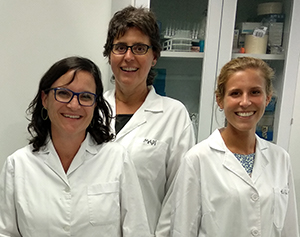Valencia, Spain
January 10, 2019

Las plantas de tomate emiten un aroma para resistir los ataques de las bacterias. Este compuesto volátil se denomina butirato de hexenilo (HB, por su sigla en inglés) y, según acaban de demostrar investigadores del Instituto de Biología Molecular y Celular de Plantas (IBMCP), centro mixto de la Universitat Politècnica de València (UPV) y el Consejo Superior de Investigaciones Científicas (CSIC), tiene un gran potencial para proteger a los cultivos frente a, entre otros, las infecciones y la sequía. Su hallazgo ha sido publicado en la revista Frontiers in Plant Science.
"La aplicación de este compuesto en campo", indica Purificación Lisón, investigadora del IBMCP (UPV-CSIC), "permitiría al sector disponer de una nueva estrategia natural para mejorar el rendimiento de los cultivos. Los tratamientos protegerían a los cultivos frente estreses bióticos y abióticos de una forma sencilla, barata y muy eficaz".
Capaz de cerrar estomas, de fácil uso, nula toxicidad y bajo coste
El compuesto es capaz de cerrar estomas, que es la clave en la protección de la planta, y según apuntan los investigadores del IBMCP (UPV-CSIC), no existe ningún producto en el mercado con estas propiedades, de ahí su importancia para el sector agronómico. Además, es de fácil uso, ya que, al tratarse de un compuesto volátil, puede aplicarse tanto pulverizándolo sobre la planta como a través de dispositivos difusores.
Entre sus propiedades, este compuesto destaca a su vez por su nula toxicidad -no en vano, su uso está aprobado también en alimentación- y bajo coste. Además, su síntesis es muy sencilla y, según las pruebas realizadas en los laboratorios del IBMCP (UPV-CSIC), es muy eficaz, por lo que no se requiere de grandes dosis.
A través de su trabajo, los investigadores han demostrado que el tratamiento de plantas de tomate con dicho compuesto produce el cierre estomático y las protege frente a la infección por la bacteria Pseudomonas syringae, aumentando así su resistencia a la misma. Así mismo, han observado que las plantas de tomate tratadas también son más tolerantes a la sequía. Además, han confirmado su eficacia para producir el cierre estomático en diversas especies vegetales, en concreto, de las familias del tomate, el maíz, la alfalfa, los cítricos y el tabaco.
"Esto es lo que hemos demostrado hasta ahora" afirma Lisón, "pero el potencial de este compuesto es enorme. De hecho, podría servir como barrera no sólo frente a situaciones de sequía, sino también para proteger a las plantas de otras infecciones provocadas por diferentes patógenos cuya puerta de entrada son los estomas".
Control de la maduración
Junto a todo lo anterior, otra de sus aplicaciones podría ser el control de los procesos de desarrollo y maduración. En este caso, los tratamientos con el compuesto podrían utilizarse para conseguir, de manera controlada, que las plantas tratadas entrasen en una especie de "letargo" inducido, ya que el cierre estomático lleva consigo el retraso en los procesos del desarrollo. Esto podría proporcionar al agricultor una nueva estrategia para el control de los momentos de recolección, adaptándose mejor a las necesidades del mercado.
En este trabajo ha colaborado también el Departamento de Ciencias Hortícolas de la Universidad de Florida (Estados Unidos).
Tomato plant aroma to protect crops
Tomato plants emit an aroma in order to resist bacterial attacks. This aroma– volatile compound –is named hexenyl butyrate (HB) and, according to the test done by researchers at the Institute for Plant Molecular and Cellular Biology, a joint center of the Universitat Politècnica de València (UPV) and the Spanish National Research Council (CSIC, in Spanish), has great potential for protecting crops from infections, drought, etc. The finding has been published in the journal Frontiers in Plant Science.
“The application of this compound in fields will allow the industry to have a new natural strategy for improving crop yields: treatments will protect crops from biotic and abiotic stress easily, efficiently and at a low cost,” says Purificación Lisón, researcher at the Institute for Plant Molecular and Cellular Biology (UPV-CSIC.)
This compound can be used for closing the stomata, which is the key in protecting plants. According to the researchers at IBMCP, there are no other products on the market with these properties, hence why it is very significant for the farming industry. Another advantage is that it is easy to use. Since it is a volatile compound, it can be applied by spraying onto plants and also by using diffuser devices.
The properties of this compound include zero toxicity -its use is also approved in food- and it has a low cost. In addition, it is easily synthetized and according to the tests done at the laboratories of the IBMCP, it is highly efficient, so the users don’t need to apply high doses.
The researchers have proven that the treatment of the tomato plants with this compound causes the closing of the stomata and protects them from infection by the Pseudomonas syringae bacteria, increasing their resistance to it. In addition, they have observed that the treated tomato plants are more tolerant to drought. They have also confirmed its efficiency in causing the stomata-closing in several species of vegetables, especially from the tomato, corn, alfalfa citrus and tobacco families.
“This is what we have demonstrated up until this point, but the compound has huge potential. It can be used as a protective barrier against situations such as drought and to protect plants from other infections produced by several pathogens whose entrance door is the stomata,” says Purificación Lisón, researcher at the Institute for Plant Molecular and Cellular Biology (UPV-CSIC.)
Controlled ripening
Another application could be controlling fruit development and the ripening processes. In those cases, treatment with the compound could be used in order to cause, in a controlled manner, treated plants to enter an induced “lethargy” of sorts, as the stomata-closing involves delaying the development processes. This could provide farmers a new strategy for controlling harvest times and adjust them better to the needs of the market.
The Department of Horticultural Sciences of the University of Florida (USA) also collaborated with this project.






















